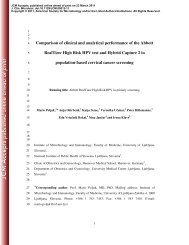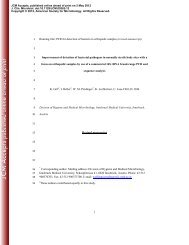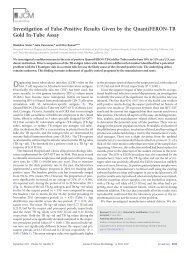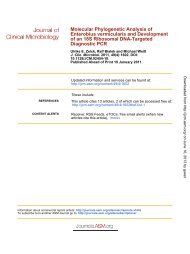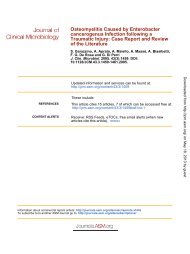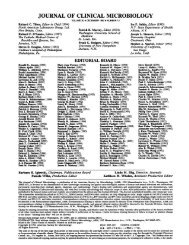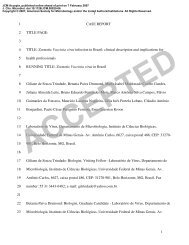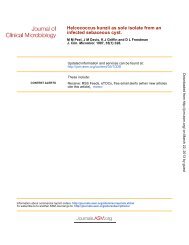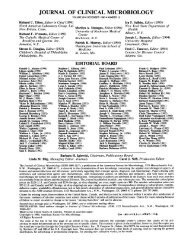Evaluation of Roche Amplicor PCR assay for Mycobacterium ...
Evaluation of Roche Amplicor PCR assay for Mycobacterium ...
Evaluation of Roche Amplicor PCR assay for Mycobacterium ...
You also want an ePaper? Increase the reach of your titles
YUMPU automatically turns print PDFs into web optimized ePapers that Google loves.
<strong>Evaluation</strong> <strong>of</strong> <strong>Roche</strong> <strong>Amplicor</strong> <strong>PCR</strong> <strong>assay</strong> <strong>for</strong><br />
<strong>Mycobacterium</strong> tuberculosis.<br />
W L Wobeser, M Krajden, J Conly, H Simpson, B Yim, M D'costa,<br />
M Fuksa, C Hian-Cheong, M Patterson, A Phillips, R Bannatyne,<br />
A Haddad, J L Brunton and S Krajden<br />
J. Clin. Microbiol. 1996, 34(1):134.<br />
CONTENT ALERTS<br />
Updated in<strong>for</strong>mation and services can be found at:<br />
http://jcm.asm.org/content/34/1/134<br />
These include:<br />
Receive: RSS Feeds, eTOCs, free email alerts (when new articles<br />
cite this article), more»<br />
Downloaded from http://jcm.asm.org/<br />
on August 27, 2013 by guest<br />
In<strong>for</strong>mation about commercial reprint orders: http://journals.asm.org/site/misc/reprints.xhtml<br />
To subscribe to to another ASM Journal go to: http://journals.asm.org/site/subscriptions/
JOURNAL OF CLINICAL MICROBIOLOGY, Jan. 1996, p. 134–139 Vol. 34, No. 1<br />
0095-1137/96/$04.000<br />
Copyright 1996, American Society <strong>for</strong> Microbiology<br />
<strong>Evaluation</strong> <strong>of</strong> <strong>Roche</strong> <strong>Amplicor</strong> <strong>PCR</strong> Assay <strong>for</strong><br />
<strong>Mycobacterium</strong> tuberculosis<br />
WENDY L. WOBESER, 1,2 MEL KRAJDEN, 1,2 JOHN CONLY, 1,2 HELEN SIMPSON, 2 BIANCHE YIM, 3<br />
MARIO D’COSTA, 1,3 MILAN FUKSA, 3 CLENCY HIAN-CHEONG, 3 MAX PATTERSON, 1,3<br />
ANNE PHILLIPS, 1,2 ROBERT BANNATYNE, 1,4 ALBERT HADDAD, 5<br />
JAMES L. BRUNTON, 1,2 AND SIGMUND KRAJDEN 1,3 *<br />
University <strong>of</strong> Toronto, 1 Departments <strong>of</strong> Microbiology, The Toronto Hospital, 2 St. Michael’s Hospital, 4<br />
St. Joseph’s Health Center, 3 and Laboratory Services Branch,<br />
Ministry <strong>of</strong> Health, 5 Toronto, Ontario, Canada<br />
Received 10 July 1995/Returned <strong>for</strong> modification 18 August 1995/Accepted 27 October 1995<br />
The <strong>Roche</strong> <strong>Amplicor</strong> <strong>Mycobacterium</strong> tuberculosis <strong>PCR</strong> test (RMtb-<strong>PCR</strong>) was compared with mycobacterial<br />
culture, with the BACTEC 460 system and inoculation on Lowenstein-Jensen media. Results were interpreted<br />
with an adjusted ‘‘gold standard’’ incorporating clinical diagnosis. A total <strong>of</strong> 1,480 clinical specimens from<br />
1,155 patients, including tissues and fluids, as well as 141 specimens which demonstrated a positive growth<br />
index on the BACTEC 460 system were assessed. The sensitivity, specificity, and positive and negative predictive<br />
values <strong>of</strong> RMtb-<strong>PCR</strong> compared with the adjusted gold standard <strong>for</strong> clinical specimens were 79, 99, 93, and<br />
98%, respectively. In smear-positive specimens, the sensitivity <strong>of</strong> RMtb-<strong>PCR</strong> was 98% versus 53% <strong>for</strong> smearnegative<br />
specimens. When RMtb-<strong>PCR</strong> was per<strong>for</strong>med two times per week, <strong>PCR</strong> results were available an<br />
average <strong>of</strong> 21 days be<strong>for</strong>e the culture results. For specimens demonstrating a positive growth index on the<br />
BACTEC 460 system, RMtb-<strong>PCR</strong> had a sensitivity and specificity <strong>of</strong> 98 and 100%, respectively. This study<br />
demonstrates the value <strong>of</strong> a commercial nucleic acid amplification kit <strong>for</strong> rapid diagnosis <strong>of</strong> M. tuberculosis,<br />
particularly in smear-positive specimens or BACTEC culture-positive specimens.<br />
The importance <strong>of</strong> tuberculosis as a global public health<br />
concern has been emphasized by high incidence rates (particularly<br />
in human immunodeficiency virus [HIV]-positive individuals,<br />
the homeless, and prisoners) and by recent outbreaks<br />
<strong>of</strong> multidrug-resistant tuberculosis in the United States (3, 7,<br />
13). Factors contributing to the outbreaks have included delays<br />
in the diagnosis and implementation <strong>of</strong> proper infection control<br />
measures, as well as delays in the institution <strong>of</strong> appropriate<br />
chemotherapy (5). <strong>Mycobacterium</strong> tuberculosis is easily spread<br />
by aerosols, and it is generally recommended that hospitalized<br />
patients whose respiratory specimens are smear positive <strong>for</strong><br />
acid-fast bacilli should be kept in respiratory isolation <strong>for</strong> 2<br />
weeks until treated. This may be costly, inconvenient, and<br />
inappropriate if the isolate is confirmed to be a <strong>Mycobacterium</strong><br />
sp. other than M. tuberculosis (MOTT). Conventional diagnosis<br />
<strong>of</strong> M. tuberculosis by culture generally takes 3 to 8 weeks.<br />
Acid-fast smears lack sensitivity (22) and cannot distinguish M.<br />
tuberculosis from other mycobacteria. Rapid differentiation <strong>of</strong><br />
M. tuberculosis from other mycobacterial species is there<strong>for</strong>e <strong>of</strong><br />
great potential benefit.<br />
The <strong>PCR</strong> can provide a rapid and specific identification <strong>of</strong><br />
M. tuberculosis complex organisms. Since 1990, more than 25<br />
studies have been published about the detection <strong>of</strong> M. tuberculosis<br />
by this method. These studies have employed a number<br />
<strong>of</strong> different genetic elements <strong>for</strong> amplification (including<br />
IS6110 [9, 12, 15], the 65-kDa antigen [4, 26], and the 38-kDa<br />
antigen [14, 24]) and have utilized a number <strong>of</strong> different DNA<br />
extraction, amplification, and detection methodologies. These<br />
studies have demonstrated that <strong>PCR</strong> is a powerful tool <strong>for</strong> the<br />
amplification and detection <strong>of</strong> mycobacterium-specific nucleic<br />
* Corresponding author. Mailing address: Department <strong>of</strong> Microbiology,<br />
St. Joseph’s Health Center, 30 The Queensway, Toronto, Ontario,<br />
Canada M6R 1B5. Phone: (416) 530-6268. Fax: (416) 530-6590.<br />
acids. However, concerns about the sensitivity, specificity, and<br />
reproducibility <strong>of</strong> in-house <strong>PCR</strong> <strong>assay</strong>s which are poorly standardized<br />
between centers (21) have slowed the endorsement <strong>of</strong><br />
this technology by regulatory bodies (6).<br />
Given these concerns, we designed a laboratory-based prospective<br />
study with the objective <strong>of</strong> assessing the sensitivity,<br />
specificity, positive predictive value (PPV), and negative predictive<br />
value (NPV) <strong>of</strong> a commercial nucleic acid amplification<br />
kit, the <strong>Amplicor</strong> M. tuberculosis test (RMtb-<strong>PCR</strong>).<br />
MATERIALS AND METHODS<br />
Clinical specimens. During the 1-year study period, a total <strong>of</strong> 1,480 specimens<br />
from 1,155 patients were processed <strong>for</strong> mycobacteria. Clinical specimens were<br />
submitted to the Mycobacteriology Laboratory <strong>of</strong> The Toronto Hospital from a<br />
consortium <strong>of</strong> tertiary care and community-based hospitals. Specimens were<br />
transported to the laboratory within 2 days <strong>of</strong> collection and were stored at 4C<br />
until processed. Specimens from contaminated sites (bronchoalveolar lavage<br />
[BAL], sputa, tissues, fluids other than cerebrospinal fluid [CSF]) were digested<br />
and decontaminated with a final concentration <strong>of</strong> 2.5% NaOH and N-acetyl-Lcysteine<br />
and concentrated by centrifugation at 3,500 g <strong>for</strong> 15 min (19). Tissues<br />
were homogenized by either the Stomacher Lab-Blender 80 (Seward Medical<br />
UAV House, London, United Kingdom) or by a sterile disposable tissue grinder<br />
(Sage Products, Inc., Crystal Lake, Ill.) on the basis <strong>of</strong> tissue size prior to<br />
decontamination and concentration. CSF samples were processed without prior<br />
decontamination (see ‘‘DNA preparation’’). After concentration, a residual volume<br />
<strong>of</strong> 2 to 3 ml remained. One milliliter was aliquoted <strong>for</strong> <strong>PCR</strong> testing and<br />
stored at 4C; 0.5 ml was inoculated into a BACTEC 12B bottle, which was<br />
incubated at 37C. The growth indices <strong>of</strong> the 12B bottles were assessed with a<br />
BACTEC 460 instrument (Becton Dickinson, Cockeysville, Md.) twice weekly<br />
<strong>for</strong> the first 2 weeks and weekly thereafter <strong>for</strong> up to 6 weeks. Another 0.5 ml was<br />
inoculated onto a Lowenstein-Jensen (Difco laboratories, Detroit, Mich.) slope,<br />
which was incubated in 5% CO 2 at 37C. Slopes were inspected weekly <strong>for</strong> up to<br />
8 weeks. Smears were stained with auramine-rhodamine and examined under<br />
400 power with a Leitz epifluorescence microscope (19). Smears were considered<br />
positive if at least one fluorescent bacillus was visualized. All positive smears<br />
were confirmed by restaining with a modified Kinyoun stain (8) and independently<br />
verified by at least two technologists. Specimens from one contributing<br />
hospital were divided be<strong>for</strong>e decontamination, concentration, and <strong>PCR</strong> (see<br />
Discussion). Culture-positive specimens were identified by the Ontario Provincial<br />
Health Laboratory by nucleic acid hybridization testing (Accuprobe; Gen<br />
Downloaded from http://jcm.asm.org/ on August 27, 2013 by guest<br />
134
VOL. 34, 1996 ROCHE AMPLICOR <strong>PCR</strong> ASSAY FOR M. TUBERCULOSIS 135<br />
Species<br />
TABLE 1. Species distribution and smear results <strong>for</strong><br />
cultures growing mycobacteria<br />
All clinical specimens<br />
No. <strong>of</strong><br />
specimens<br />
No. (%) smear<br />
positive<br />
Probe, Inc., San Diego, Calif.) and conventional biochemical testing (19). There<br />
were 630 sputa, 445 BALs, 236 biopsies, 90 normally sterile fluids, 52 aspirates,<br />
22 CSF samples, 4 urine samples, and 1 blood sample. In addition, 141 specimens<br />
whose growth indices exceeded 10 in BACTEC bottles were processed <strong>for</strong> RMtb-<br />
<strong>PCR</strong>.<br />
DNA preparation, amplification, and detection by RMtb-<strong>PCR</strong>. <strong>PCR</strong> was per<strong>for</strong>med<br />
according to the manufacturer’s instructions with the RMtb-<strong>PCR</strong> (<strong>Roche</strong><br />
<strong>PCR</strong> Diagnostics, Inc., Branchburg, N.J.). DNA preparation was per<strong>for</strong>med in a<br />
laminar air flow biosafety hood in an area separated from the specimen processing<br />
area. A volume <strong>of</strong> 100 l <strong>of</strong> each specimen (or the vortexed, unconcentrated<br />
BACTEC 12B contents) was used <strong>for</strong> each amplification. Specimens were<br />
washed, lysed, and neutralized according to the manufacturer’s protocol. CSF<br />
specimens were run in duplicate, with one receiving the normal wash treatment<br />
and the other not receiving the wash as a precaution against insufficient precipitation<br />
<strong>of</strong> nucleic acids after the wash step. One positive control and two negative<br />
controls supplied by <strong>Roche</strong> were included in every run. Amplification reagents<br />
were prepared on the day <strong>of</strong> utilization. False-positive results due to amplicon<br />
contamination were minimized through the use <strong>of</strong> uracil-N-glycosylase (Amp-<br />
Erase). A 35-cycle procedure was used with a GeneAmp <strong>PCR</strong> system 9600<br />
(Perkin Elmer): 20 s at 94C,20sat62C, and 45 s at 72C. The final elongation<br />
step was continued <strong>for</strong> 5 min at 72C, and the product was held at 72C. <strong>PCR</strong><br />
product detection was per<strong>for</strong>med on the same day as amplification. Amplification<br />
products and hybridization buffer were transferred to microwell plates<br />
coated with oligonucleotides specific <strong>for</strong> M. tuberculosis complex. After incubation<br />
at 37C <strong>for</strong> 1.5 h, the plates were washed five times. Avidin-horseradish<br />
peroxidase conjugate and substrate were added. Samples were considered positive<br />
if the A 450 was equal to or greater than 0.35.<br />
Discrepant result analysis. RMtb-<strong>PCR</strong> was repeated when possible on specimens<br />
which were RMtb-<strong>PCR</strong> negative and culture positive <strong>for</strong> M. tuberculosis.<br />
The medical records <strong>of</strong> all patients who had positive RMtb-<strong>PCR</strong> and negative<br />
culture results were reviewed by the investigators. Data concerning the clinical<br />
presentation, epidemiologic risk factors, past culture results, and previous or<br />
current therapy were analyzed. Additional specimens were examined if available.<br />
After this analysis, the <strong>PCR</strong> result was reclassified as appropriate. The combination<br />
<strong>of</strong> culture and clinical data was utilized to generate an adjusted gold<br />
standard.<br />
Statistical methods. Data were entered into a Epi-Info 6.00 database (Centers<br />
<strong>for</strong> Disease Control and Prevention, Atlanta, Ga.). Continuous variables were<br />
compared by Student’s t test. Sensitivities were compared by McNemar’s chisquare<br />
test.<br />
RESULTS<br />
No. <strong>of</strong><br />
specimens<br />
Sputum or BAL<br />
No. (%) smear<br />
positive<br />
M. tuberculosis 100 56 (56) 59 40 (68)<br />
MAC 57 17 (30) 51 15 (29)<br />
M. xenopi 43 4 (9) 43 4 (9)<br />
M. <strong>for</strong>tuitum 7 0 7 0<br />
M. chelonae 1 0 1 0<br />
M. gordonae 1 0 1 0<br />
M. kansasii 2 2 (100) 2 2 (100)<br />
M. szulgae 1 1 (100) 1 1 (100)<br />
Other MOTT 6 1 (17) 5 1 (20)<br />
All 218 81 (37) a 170 63 (37) b<br />
a Fifty-six <strong>of</strong> 81 specimens (69%) grew M. tuberculosis.<br />
b Forty <strong>of</strong> 63 specimens (63%) grew M. tuberculosis.<br />
Species distribution and smear results. A total <strong>of</strong> 1,480<br />
specimens were processed from 1,155 patients <strong>for</strong> both culture<br />
and RMtb-<strong>PCR</strong>. Mycobacterial species were grown from 218<br />
<strong>of</strong> 1,480 specimens (15%), <strong>of</strong> which 100 <strong>of</strong> 218 specimens<br />
(46%) grew M. tuberculosis. Culture and smear results <strong>for</strong> the<br />
identified mycobacterium species are shown in Table 1. Over<br />
half, 56 <strong>of</strong> 100 (56%), <strong>of</strong> the specimens which grew M. tuberculosis<br />
were positive by smear. Among specimens positive <strong>for</strong><br />
MOTT, 57 <strong>of</strong> 118 (48%) grew <strong>Mycobacterium</strong> avium complex<br />
(MAC) and 43 <strong>of</strong> 118 (36%) grew <strong>Mycobacterium</strong> xenopi (M.<br />
xenopi is one <strong>of</strong> the most common MOTT found in Ontario,<br />
Canada [23]). When only respiratory specimens are considered<br />
(sputum and BAL), 40 <strong>of</strong> 59 (68%) <strong>of</strong> the specimens growing<br />
M. tuberculosis were positive by smear, as were 15 <strong>of</strong> 51 (29%)<br />
<strong>of</strong> the MAC isolates and 4 <strong>of</strong> 43 (9%) <strong>of</strong> the M. xenopi isolates.<br />
Of all smear-positive respiratory specimens, 40 <strong>of</strong> 63 (63%)<br />
grew M. tuberculosis. A total <strong>of</strong> eight smear-positive respiratory<br />
specimens failed to grow mycobacteria, two <strong>of</strong> which were<br />
positive by RMtb-<strong>PCR</strong>.<br />
Comparison <strong>of</strong> smear, culture, and <strong>PCR</strong> results. Table 2<br />
demonstrates the relationship between culture, smear, and<br />
RMtb-<strong>PCR</strong> results excluding BACTEC-cultivated specimens.<br />
M. tuberculosis was cultivated in 77 specimens which were<br />
also positive by RMtb-<strong>PCR</strong>. M. tuberculosis was not cultivated<br />
in 1,362 specimens that were also negative by RMtb-<strong>PCR</strong>. A<br />
total <strong>of</strong> 23 specimens were M. tuberculosis positive only by<br />
culture, and 18 were positive only by RMtb-<strong>PCR</strong>. The smear<br />
positivity rate was 55 <strong>of</strong> 77 specimens (71%) in culture-positive<br />
specimens which were also RMtb-<strong>PCR</strong> positive, whereas in<br />
specimens which were culture positive and RMtb-<strong>PCR</strong> negative,<br />
the smear positivity rate was only 4%. Details <strong>of</strong> the<br />
discordant results are given in Tables 4 and 5 (see below).<br />
The overall sensitivity <strong>of</strong> RMtb-<strong>PCR</strong> <strong>for</strong> specimens which<br />
were M. tuberculosis culture positive was 77%, whereas the<br />
sensitivity <strong>for</strong> smear was 56%. With McNemar’s chi-square<br />
test, the difference is significant at P 0.01. The PPVs and<br />
NPVs <strong>of</strong> RMtb-<strong>PCR</strong> versus culture were 77 and 98%, respectively.<br />
Of all 56 specimens that were smear and culture positive <strong>for</strong><br />
M. tuberculosis, all but 1 (98%) was also positive by RMtb-<br />
<strong>PCR</strong>. Of the 44 specimens negative by smear and positive by<br />
culture <strong>for</strong> M. tuberculosis, 22 (50%) were positive by RMtb-<br />
<strong>PCR</strong>. For respiratory specimens, 40 were positive by smear and<br />
culture <strong>for</strong> M. tuberculosis, and all were positive by RMtb-<strong>PCR</strong>.<br />
Of the 19 respiratory specimens which were smear negative<br />
and culture positive, 9 <strong>of</strong> 19 were also RMtb-<strong>PCR</strong> positive<br />
(47%). RMtb-<strong>PCR</strong> was repeated <strong>for</strong> 6 <strong>of</strong> the 10 false-negative<br />
specimens, but in only one case was the repeated result positive.<br />
The distribution <strong>of</strong> culture-positive specimens by RMtb-<br />
<strong>PCR</strong> result is given in Table 3. The sensitivities <strong>of</strong> RMtb-<strong>PCR</strong><br />
<strong>for</strong> sputum and BAL were comparable (84 and 81%, respectively).<br />
The sensitivity <strong>of</strong> RMtb-<strong>PCR</strong> <strong>for</strong> biopsy specimens was<br />
74% (this difference was not significant). The numbers <strong>of</strong> M.<br />
tuberculosis culture-positive aspirates, fluids, and CSFs were<br />
too few to draw specific conclusions regarding the comparative<br />
per<strong>for</strong>mance <strong>of</strong> RMtb-<strong>PCR</strong> (Table 3).<br />
TABLE 2. Detection <strong>of</strong> M. tuberculosis by RMtb-<strong>PCR</strong><br />
versus culture in 1,480 clinical specimens a<br />
Culture result<br />
(no. <strong>of</strong> specimens)<br />
No. <strong>of</strong> RMtb-<strong>PCR</strong>-tested<br />
specimens (% smear positive)<br />
Positive Negative<br />
Positive <strong>for</strong> M. tuberculosis (100) 77 (71) b 23 c (4) b<br />
Negative <strong>for</strong> M. tuberculosis (1,380) 18 d 1,362 e<br />
Total 95 1,385<br />
a A total <strong>of</strong> 1,155 patients provided specimens. Note that BACTEC specimens<br />
were excluded.<br />
b 71% 55 <strong>of</strong> 77 and 4% 1 <strong>of</strong> 23. Overall, 56% (56 <strong>of</strong> 100) <strong>of</strong> the<br />
culture-positive specimens were smear positive.<br />
c Details are given in Table 4.<br />
d Details are given in Table 5 (includes five MOTT).<br />
e Includes 113 MOTT.<br />
Downloaded from http://jcm.asm.org/ on August 27, 2013 by guest
136 WOBESER ET AL. J. CLIN. MICROBIOL.<br />
<strong>PCR</strong><br />
result<br />
TABLE 3. Distribution <strong>of</strong> specimens which were culture<br />
positive <strong>for</strong> M. tuberculosis<br />
No. <strong>of</strong> samples from:<br />
Sputum BAL Aspirate Biopsy Fluid CSF<br />
Positive 36 13 4 20 2 2<br />
Negative 7 3 3 7 1 2<br />
Total 43 16 7 27 3 4<br />
TABLE 4. Analysis <strong>of</strong> 24 specimens from 22 patient culture<br />
positive <strong>for</strong> M. tuberculosis and negative by RMtb-<strong>PCR</strong> a<br />
Analysis <strong>of</strong> discordant results with the adjusted gold standard.<br />
Discordance between different detection <strong>assay</strong>s may be<br />
related to the <strong>assay</strong> design or its per<strong>for</strong>mance characteristics.<br />
For example, DNA amplification techniques may detect nucleic<br />
acid from both viable and nonviable organisms. There<strong>for</strong>e,<br />
patients receiving therapy may have a positive <strong>PCR</strong> result<br />
despite being culture negative. To address this possibility, we<br />
incorporated an adjusted gold standard which included clinical<br />
and treatment data.<br />
(i) Culture-positive, RMtb-<strong>PCR</strong>-negative specimens. Table<br />
4 gives a detailed analysis <strong>of</strong> the 24 specimens from 22 patients<br />
which were positive by culture <strong>for</strong> M. tuberculosis and negative<br />
by RMtb-<strong>PCR</strong>. The single false-negative RMtb-<strong>PCR</strong> specimen<br />
which was smear positive was on a peritoneal dialysate which<br />
had not been concentrated. After concentration <strong>of</strong> this sample,<br />
the RMtb-<strong>PCR</strong> was positive. The first culture-positive CSF we<br />
tested was RMtb-<strong>PCR</strong> negative after washing as per the manufacturer’s<br />
directions. Because <strong>of</strong> concerns that the washing<br />
step could have resulted in the loss <strong>of</strong> amplifiable target, we<br />
split subsequent CSFs into washed and unwashed specimens<br />
prior to per<strong>for</strong>mance <strong>of</strong> RMtb-<strong>PCR</strong>. An additional two CSFs<br />
were both culture and RMtb-<strong>PCR</strong> positive—one in both the<br />
washed and unwashed specimens and one in only the washed<br />
specimen. (One CSF was only positive by RMtb-<strong>PCR</strong> but was<br />
negative on culture. This patient was undergoing treatment<br />
[Table 5].) An additional three specimens (one <strong>of</strong> each biopsy,<br />
BACTEC and sputum) were positive on repeat RMtb-<strong>PCR</strong>, 10<br />
were negative on repeat RMtb-<strong>PCR</strong>, and 8 were not repeated<br />
because <strong>of</strong> a lack <strong>of</strong> sufficient specimen. Specimens divided<br />
prior to concentration and homogenization (from one hospital<br />
site) did not differ from other specimens in the rate <strong>of</strong> smear,<br />
culture, or RMtb-<strong>PCR</strong> positivity.<br />
(ii) Culture-negative, RMtb-<strong>PCR</strong>-positive specimens. A total<br />
<strong>of</strong> 18 specimens from 16 patients were initially classified as<br />
RMtb-<strong>PCR</strong> false positive with culture as the gold standard<br />
(Table 5). However, after review, 11 <strong>of</strong> 18 specimens (nine<br />
patients) were reclassified as true positives, 6 specimens remained<br />
as false positives (1 because <strong>of</strong> laboratory contamination),<br />
and 1 specimen was indeterminate. Six <strong>of</strong> the 16 patients<br />
(eight specimens) were undergoing treatment at the time the<br />
specimen was obtained (treatment duration ranging from 2 to<br />
130 weeks). The patient who had been on treatment <strong>for</strong> 130<br />
weeks was HIV positive, known to be noncompliant, and had<br />
severe disease, as shown by a chest radiograph. We concluded<br />
that all six <strong>of</strong> these patients were true positives. One patient<br />
classified as true positive had been treated <strong>for</strong> tuberculosis 1<br />
year earlier and had a persistent cavitary lesion. At a 1-year<br />
follow-up, without treatment, this patient remained asymptomatic<br />
and showed almost complete resolution <strong>of</strong> the radiological<br />
abnormality. Three other patients were started on antituberculous<br />
therapy after the RMtb-<strong>PCR</strong> result, two <strong>of</strong> three having<br />
clinical and histopathological evidence <strong>of</strong> tuberculosis. One <strong>of</strong><br />
three patients was from an area endemic <strong>for</strong> tuberculosis and<br />
had bilateral lower lobe pneumonia, which on pathology demonstrated<br />
bronchiolitis obliterans and organizing pneumonia.<br />
This patient was started on steroids in addition to antituberculous<br />
therapy, with a partial clinical response. We classified<br />
the two <strong>for</strong>mer patients as true positives; the third patient was<br />
classified as indeterminate.<br />
Four patients grew M. xenopi, all from respiratory specimens.<br />
One <strong>of</strong> the four had severe cavitary disease, multiple<br />
positive cultures, and was on therapy; the three remaining had<br />
no significant pulmonary disease (one had recently been<br />
treated with intravesicular <strong>Mycobacterium</strong> bovis BCG <strong>for</strong> bladder<br />
carcinoma). One other patient with chronic lung disease<br />
presumed to be due to MAC and on therapy against MAC was<br />
positive by RMtb-<strong>PCR</strong> on two occasions. One patient (postliver<br />
transplant) with no evidence <strong>of</strong> tuberculosis was <strong>PCR</strong><br />
positive, likely as a result <strong>of</strong> laboratory contamination.<br />
Table 6 summarizes the per<strong>for</strong>mance <strong>of</strong> RMtb-<strong>PCR</strong> versus<br />
culture and the adjusted gold standard. With the adjusted gold<br />
standard, the overall sensitivity in clinical specimens was 79%<br />
and the specificity was 99%. The PPV was 93%, and the NPV<br />
was 98% (Table 6). For smear-positive specimens, the sensitivity<br />
was unchanged at 98%, and the sensitivity <strong>for</strong> smearnegative<br />
samples rose to 53%. The sensitivity and specificity <strong>of</strong><br />
RMtb-<strong>PCR</strong> with the adjusted gold standard <strong>for</strong> respiratory<br />
specimens were 84% and 99%, respectively.<br />
BACTEC specimens. A total <strong>of</strong> 141 BACTEC specimens<br />
with positive growth indices were processed <strong>for</strong> RMtb-<strong>PCR</strong>.<br />
The average growth index (at the time RMtb-<strong>PCR</strong> was per<strong>for</strong>med)<br />
was 299 (range, 10 to 999). M. tuberculosis was cultured<br />
from 50 specimens (35%), MAC was cultured from 49<br />
specimens (34%), and M. xenopi was cultured from 35 speci-<br />
Patient<br />
Specimen<br />
Result by:<br />
Smear Repeat b<br />
Comment(s)<br />
1 BAL Negative NSQ c<br />
2 Biopsy Negative NSQ Lymph node<br />
3 CSF Negative Positive (wash) d BAL RMtb-<strong>PCR</strong> positive<br />
4 BAL Negative Negative<br />
5 Biopsy Negative Negative Lymph node<br />
6 Biopsy Negative NSQ Lymph node<br />
7 Biopsy Negative Negative Pleural<br />
8 Fluid Negative NSQ Neck abscess<br />
9 e Sputum Negative Negative<br />
10 Biopsy Negative Positive Lymph node<br />
11 Biopsy Negative NSQ Lymph node<br />
12 BAL Negative Negative Culture negative twice on<br />
the same BAL<br />
13 BACTEC Negative Positive Lymph node<br />
14 Sputum Negative Positive<br />
15 Sputum Negative Negative<br />
16 Biopsy Negative NSQ Lymph node<br />
17 CSF Negative Negative (wash) d<br />
18 Fluid Positive Positive (concn) Peritoneal dialysate, unconcentrated<br />
specimen was<br />
<strong>PCR</strong> negative<br />
19 Sputum Negative NSQ<br />
20 Sputum Negative NSQ<br />
21 e Aspirate Negative Negative<br />
22 Sputum Positive Negative RMtb-<strong>PCR</strong> run on small<br />
volume (less than 100 l)<br />
a Not tested <strong>for</strong> the presence <strong>of</strong> inhibitors.<br />
b Result <strong>of</strong> repeat <strong>PCR</strong>.<br />
c NSQ, insufficient quantity <strong>for</strong> repeat testing.<br />
d CSF specimens were run in duplicate (see Methods).<br />
e Patients with two distinct specimens.<br />
Downloaded from http://jcm.asm.org/ on August 27, 2013 by guest
VOL. 34, 1996 ROCHE AMPLICOR <strong>PCR</strong> ASSAY FOR M. TUBERCULOSIS 137<br />
TABLE 5. Analysis <strong>of</strong> 18 specimens from 16 patient cultures negative <strong>for</strong> M. tuberculosis and positive by RMtb-<strong>PCR</strong><br />
Reclassification<br />
Patient<br />
Previous<br />
TB a<br />
Clinical<br />
TB<br />
Specimen<br />
Smear<br />
Result by:<br />
Repeat <strong>PCR</strong><br />
Comment(s)<br />
Contamination 1 No No Sputum Negative NSQ b No evidence <strong>of</strong> M. tuberculosis, Liver Transplant<br />
True positive 2 c Yes Yes Sputum Positive NSQ On treatment <strong>for</strong> 6 wk, also grew M. xenopi<br />
True positive 3 c Yes Yes Sputum Positive NSQ On treatment <strong>for</strong> 130 wk, noncompliant, HIV positive<br />
True positive 4 Yes Yes Biopsy Negative NSQ On treatment <strong>for</strong> 20 wk, severe lung disease, new lymph node<br />
True positive 5 Yes Yes Biopsy Positive NSQ On treatment <strong>for</strong> 26 wk, active pericarditis at surgery<br />
True positive 6 Yes Yes Biopsy Positive NSQ On treatment <strong>for</strong> 26 wk, persistent lymph node drainage<br />
True positive 7 Yes Yes CSF Negative NSQ On treatment <strong>for</strong> 2 wk <strong>for</strong> meningitis<br />
True positive 8 No Yes Aspirate Positive NSQ Treated <strong>for</strong> TB, apical pneumonia, AFB d positive on pathology<br />
True positive 9 No Yes Biopsy Negative NSQ Treated <strong>for</strong> TB, lymph node AFB positive on pathology<br />
True positive 10 Yes No BAL Negative NSQ Previously treated <strong>for</strong> M. tuberculosis 1 year ago, persistent cavity<br />
False positive 11 No No Sputum Positive Yes/negative Cavitary lung disease, multiple cultures positive <strong>for</strong> M. xenopi only<br />
False positive 12 No No Sputum Negative NSQ Not treated <strong>for</strong> MTB, lung nodule, 2 specimens positive <strong>for</strong> M. xenopi<br />
False positive 13 No No BAL Negative NSQ Recent treatment with BCG, granuloma on X ray, grew M. xenopi<br />
False positive 14 ? ? Sputum Negative Yes/negative Clinical data unavailable, M. xenopi<br />
False positive 15 No No Sputum Positive Yes/positive Chronic lung disease with MAC, on steroids, anti-MAC treatment<br />
Indeterminate 16 No No Biopsy Negative NSQ Treated <strong>for</strong> M. tuberculosis, bilateral lower lobe pneumonia, BOOP e<br />
a TB, tuberculosis.<br />
b NSQ, insufficient quantity <strong>of</strong> sample <strong>for</strong> retesting.<br />
c Patients 2 and 3 each had separate specimens positive by RMtb-<strong>PCR</strong> and negative by Culture.<br />
d AFB, acid-fast bacillus.<br />
e BOOP, Bronchiolitis obliterans and organizing pneumonia.<br />
mens (24%). Two each grew <strong>Mycobacterium</strong> chelonae and <strong>Mycobacterium</strong><br />
gordonae, and one grew <strong>Mycobacterium</strong> kansasii.<br />
Two grew MOTT which were not identified to the species<br />
level. Of those growing M. tuberculosis, 49 <strong>of</strong> 50 were positive<br />
by RMtb-<strong>PCR</strong> <strong>for</strong> a sensitivity <strong>of</strong> 98%. Testing <strong>of</strong> the one<br />
false-negative RMtb-<strong>PCR</strong> specimen was repeated, and the<br />
specimen was found to be positive by RMtb-<strong>PCR</strong> (Table 4).<br />
None <strong>of</strong> the 91 specimens growing MOTT were positive by<br />
RMtb-<strong>PCR</strong>, <strong>for</strong> a specificity <strong>of</strong> 100%. The PPV and NPV <strong>for</strong><br />
RMtb-<strong>PCR</strong> as applied to BACTEC were 100 and 99%, respectively.<br />
DISCUSSION<br />
Our study demonstrates the large-scale application <strong>of</strong> the<br />
commercial RMtb-<strong>PCR</strong>, a standardized nucleic acid amplification<br />
<strong>assay</strong>, <strong>for</strong> the rapid diagnosis <strong>of</strong> tuberculosis. Our results<br />
showed that the sensitivity <strong>of</strong> RMtb-<strong>PCR</strong> <strong>for</strong> all non-BACTEC<br />
specimens against an adjusted gold standard was 79%. For<br />
smear-positive specimens, the sensitivity was 98%, and <strong>for</strong><br />
smear-negative specimens, the sensitivity was 53%. This was<br />
consistent with data reported by others (1, 11, 27,). A survey <strong>of</strong><br />
state health laboratories using conventional culture revealed<br />
that the average time from the receipt <strong>of</strong> specimens to the<br />
reporting <strong>of</strong> results to a physician is 34 days (16). With<br />
BACTEC, this can be shortened to 22 days, and with the<br />
addition <strong>of</strong> nucleic acid probes, this can be shortened to 10 to<br />
14 days. Although we routinely use BACTEC in conjunction<br />
with nucleic acid probes, the turnaround time from specimen<br />
receipt to result report in our hands was 25 days, compared<br />
with 3.7 days <strong>for</strong> RMtb-<strong>PCR</strong> when the latter was run twice per<br />
week. In a high-volume laboratory, a same-day RMtb-<strong>PCR</strong><br />
result could be provided.<br />
The number <strong>of</strong> false-negative results <strong>for</strong> RMtb-<strong>PCR</strong> and the<br />
need to determine the susceptibility <strong>of</strong> the isolates illustrate<br />
that <strong>PCR</strong> technology with its current sensitivity must be per<strong>for</strong>med<br />
in conjunction with culture. Although 17 <strong>of</strong> 24 specimens<br />
had either been divided prior to concentration and homogenization<br />
or were tissue specimens which were divided<br />
prior to concentration and homogenization, they did not differ<br />
from other specimens in the rate <strong>of</strong> smear, culture, or RMtb-<br />
<strong>PCR</strong> positivity. There<strong>for</strong>e, we do not feel that prior division<br />
contributed to the number <strong>of</strong> false negatives. However, currently<br />
all specimens are homogenized prior to division <strong>for</strong><br />
culture and <strong>PCR</strong>. We did not test <strong>for</strong> the presence <strong>of</strong> inhibitors<br />
in our study, which have been reported to occur in 5 to 13% <strong>of</strong><br />
specimens (4, 20, 25) and could have been responsible <strong>for</strong><br />
some <strong>of</strong> the false-negative results.<br />
In the present study, most false-positive specimens (Table 5)<br />
were probably due to the presence <strong>of</strong> nonviable organisms in<br />
patients while on therapy. Published experience with <strong>PCR</strong> supports<br />
the concept that a patient can remain <strong>PCR</strong> positive after<br />
cultures become negative. In one study, <strong>PCR</strong> remained positive<br />
1 to 2 months after cultures became negative (17), and<br />
occasionally results can be positive at 6 months after the initiation<br />
<strong>of</strong> therapy (18). Patients that are <strong>PCR</strong> positive after 6<br />
months <strong>of</strong> treatment may be at high risk <strong>of</strong> relapse (17). Beige<br />
et al. (2) found a significant number (11 <strong>of</strong> 24) <strong>of</strong> positive <strong>PCR</strong><br />
results in a population <strong>of</strong> patients infected with M. tuberculosis<br />
but who were smear and culture negative and had no evidence<br />
<strong>of</strong> clinical disease; we found only one such patient. Only one<br />
false-positive specimen was attributed to contamination. In<br />
addition, five specimens (four M. xenopi and one MAC) may<br />
have generated false-positive results. The optical densities <strong>of</strong><br />
these specimens tended to be lower than those <strong>of</strong> specimens<br />
TABLE 6. Summary <strong>of</strong> per<strong>for</strong>mance <strong>of</strong> RMtb-<strong>PCR</strong> on the<br />
basis <strong>of</strong> culture and adjusted gold standard<br />
Specimens<br />
Adjusted gold standard [no. (%) <strong>of</strong> specimens]<br />
Sensitivity Specificity PPV NPV<br />
Clinical a 77 (79) 99 (99) 81 (93) 98 (98)<br />
Smear positive a 98 (98) 76 (93) 86 (97) 97 (97)<br />
Smear negative a 50 (53) 99 (100) 71 (81) 98 (98)<br />
Respiratory a 83 (84) 99 (99) 82 (90) 99 (99)<br />
BACTEC culture b 98 (98) 100 (100) 100 (100) 99 (99)<br />
a Includes all specimens tested directly by RMtb-<strong>PCR</strong> (i.e., no BACTEC<br />
cultures).<br />
b RMtb-<strong>PCR</strong> results from BACTEC culture (growth indices 10).<br />
Downloaded from http://jcm.asm.org/ on August 27, 2013 by guest
138 WOBESER ET AL. J. CLIN. MICROBIOL.<br />
containing M. tuberculosis but were above the <strong>assay</strong> cut<strong>of</strong>f.<br />
Although these readings may represent a biological false positive,<br />
none <strong>of</strong> 35 BACTEC specimens which grew M. xenopi (or<br />
the 49 growing MAC) were positive by RMtb-<strong>PCR</strong>. It is unlikely<br />
that these patients were dually infected with M. tuberculosis,<br />
given that only MOTT were cultured in at least two<br />
specimens from all but one patient. We are currently investigating<br />
if there is a biological basis <strong>for</strong> this potential crossreactivity.<br />
The rapid detection <strong>of</strong> mycobacteria by smear is hampered<br />
by its lack <strong>of</strong> sensitivity and its inability to differentiate between<br />
mycobacterial species. For respiratory specimens, the overall<br />
sensitivity <strong>of</strong> RMtb-<strong>PCR</strong> was 84% (98 and 56% on smearpositive<br />
and smear-negative specimens, respectively). For smearpositive<br />
specimens, rapid exclusion <strong>of</strong> M. tuberculosis can save<br />
unnecessary respiratory isolation and potential contact tracing<br />
costs. Of smear-positive respiratory isolates, 37% grew MOTT<br />
(Table 1); this is higher than numbers published by Yajko et<br />
al., who grew MOTT from 8% <strong>of</strong> smear-positive sputa and<br />
29% <strong>of</strong> smear-positive BAL (28). The differentiation <strong>of</strong> M.<br />
tuberculosis from MOTT on smear-positive specimens in a<br />
timely fashion also allows <strong>for</strong> the early institution <strong>of</strong> appropriate<br />
therapy.<br />
This study helps to define the role <strong>of</strong> <strong>PCR</strong> <strong>assay</strong>s in the<br />
management <strong>of</strong> patients with suspected tuberculosis. Two areas<br />
in which RMtb-<strong>PCR</strong> per<strong>for</strong>med well and can likely be<br />
demonstrated to be cost-effective have been identified. The<br />
first area is the early species identification <strong>of</strong> smear-positive<br />
specimens. In this setting, we found, as did D’Amato et al. (11),<br />
that a negative RMtb-<strong>PCR</strong> result virtually excluded tuberculosis.<br />
The second setting in which RMtb-<strong>PCR</strong> may be indicated<br />
is in its early application to positive BACTEC specimens.<br />
Forbes and Hicks also found <strong>PCR</strong> to be very sensitive (100%)<br />
and specific (99.7%) when applied to BACTEC specimens<br />
with a growth index greater than 10 (15). They found the time<br />
to identification <strong>of</strong> M. tuberculosis to be 14 days with <strong>PCR</strong><br />
versus 29 days with nucleic acid probes. In our hands, the<br />
RMtb-<strong>PCR</strong> result was available a mean <strong>of</strong> 4 days be<strong>for</strong>e the<br />
results <strong>of</strong> nucleic acid probe tests. Testing <strong>of</strong> all BACTEC<br />
specimens at the earliest positive growth index could increase<br />
this time advantage.<br />
At this time, the Public Health Service recommends that<br />
conventional laboratory methods (including BACTEC and nucleic<br />
acid probes) be used <strong>for</strong> the detection <strong>of</strong> M. tuberculosis<br />
(6). The appropriate application <strong>of</strong> a rapid diagnostic tool such<br />
as RMtb-<strong>PCR</strong> can dramatically shorten the time to diagnosis.<br />
Given the reliability <strong>of</strong> RMtb-<strong>PCR</strong> <strong>for</strong> smear-positive specimens<br />
and specimens positive on BACTEC, we now use RMtb-<br />
<strong>PCR</strong> routinely in these two settings. The use <strong>of</strong> the RMtb-<strong>PCR</strong><br />
test on an outsource basis <strong>for</strong> smear-positive patients is costeffective<br />
in an institution which sees cases <strong>of</strong> pulmonary<br />
MOTT to M. tuberculosis at a ratio <strong>of</strong> smear-positive cases <strong>of</strong><br />
1:8 or less by the most conservative isolation cost scenarios<br />
<strong>for</strong> which isolation days may be saved (10). The greatest potential<br />
<strong>for</strong> individual institutional cost savings is in settings with<br />
large HIV and immunosuppressed populations, in which both<br />
MOTT and M. tuberculosis are prevalent. The greatest health<br />
care savings are realized when specimens are outsourced from<br />
multiple institutions to a single central laboratory facility. To<br />
optimize tuberculosis infection control practices and to prevent<br />
future outbreaks, early diagnosis <strong>of</strong> infectious individuals<br />
is critical. The availability <strong>of</strong> highly standardized nucleic acid<br />
amplification technologies promises to be an effective tool <strong>for</strong><br />
attaining this goal.<br />
ACKNOWLEDGMENTS<br />
We thank the following members <strong>of</strong> the Toronto Rapid Diagnostics<br />
Consortium <strong>for</strong> providing specimens: A. Born and E. Szentgyorgyi,<br />
North York Branson Hospital; M. Karmali, Hospital <strong>for</strong> Sick Children;<br />
D. Low, Mount Sinai Hospital; A. Medline, Northwestern General<br />
Hospital; A. Gryfe and A. Perl, Queensway General Hospital; A.<br />
Simor, Sunnybrook Health Science Centre; R. Devlin, The Wellesley<br />
Hospital; and M. Vearncombe, Women’s College Hospital.<br />
REFERENCES<br />
1. Beavis, K. G., M. B. Lichty, D. L. Jungkind, and O. Giger. 1995. <strong>Evaluation</strong><br />
<strong>of</strong> <strong>Amplicor</strong> <strong>PCR</strong> <strong>for</strong> direct detection <strong>of</strong> <strong>Mycobacterium</strong> tuberculosis from<br />
sputum specimens. J. Clin. Microbiol. 33:2582–2586.<br />
2. Beige, J., J. Lokies, T. Schaberg, U. Finckh, M. Fischer, H. Mauch, H. Lode,<br />
B. Köhler, and A. Rolfs. 1995. Clinical evaluation <strong>of</strong> a <strong>Mycobacterium</strong> tuberculosis<br />
<strong>PCR</strong> <strong>assay</strong>. J. Clin. Microbiol. 33:90–95.<br />
3. Bloom, B. R. 1992. Tuberculosis—back to a frightening future. Nature (London)<br />
358:538–539.<br />
4. Brisson-Noel, A., C. Aznar, C. Chureau, S. Nguyen, C. Pierre, M. Bartoli, R.<br />
Bonete, G. Pialoux, B. Gicquel, and G. Garrigue. 1991. Diagnosis <strong>of</strong> tuberculosis<br />
by DNA amplification in clinical practice evaluation. Lancet 338:<br />
364–366.<br />
5. Centers <strong>for</strong> Disease Control and Prevention. 1991. Nosocomial transmission<br />
<strong>of</strong> multidrug-resistant tuberculosis among HIV-infected persons—Florida<br />
and New York, 1988–1991. Morbid. Mortal. Weekly Rep. 40:585–591.<br />
6. Centers <strong>for</strong> Disease Control and Prevention. 1993. Diagnosis <strong>of</strong> tuberculosis<br />
by nucleic acid amplification methods applied to clinical specimens. Morbid.<br />
Mortal. Weekly Rep. 42:686.<br />
7. Centers <strong>for</strong> Disease Control and Prevention. 1993. Tuberculosis morbidity—<br />
United States 1992. Morbid. Mortal. Weekly Rep. 42:696–704.<br />
8. Chain, K., 1995. Clinical microscopy, p. 33–51. In P. R. Murray, E. J. Baron,<br />
M. A. Pfaller, F. C. Tenover, and R. H. Yolken (ed.), Manual <strong>of</strong> clinical<br />
microbiology, 6th ed. American Society <strong>for</strong> Microbiology, Washington, D.C.<br />
9. Clarridge, J. E., III, R. M. Shawar, T. M. Shinnick, and B. B. Plikaytis. 1993.<br />
Large-scale use <strong>of</strong> polymerase chain reaction <strong>for</strong> detection <strong>of</strong> <strong>Mycobacterium</strong><br />
tuberculosis in a routine mycobacteriology laboratory. J. Clin. Microbiol. 31:<br />
2049–2056.<br />
10. Conly, J., S. Krajden, M. Krajden, R. Bannatyne, W. Wobeser, and The<br />
Toronto Rapid Diagnostics Consortium. 1995. Conventional vs rapid molecular<br />
diagnostic strategies <strong>for</strong> M. tuberculosis (M.tb): a cost-effectiveness<br />
analysis (CEA), abstr. D93, p. 83. In Program and abstracts <strong>of</strong> the 35th<br />
Interscience Conference on Antimicrobial Agents and Chemotherapy.<br />
American Society <strong>for</strong> Microbiology, Washington, D.C.<br />
11. D’Amato, R. F., A. A. Wallman, L. H. Hochstein, P. M. Colaninno, M.<br />
Scardamaglia, E. Ardila, M. Ghouri, K. Kim, R. C. Patel, and A. Miller.<br />
1995. Rapid diagnosis <strong>of</strong> pulmonary tuberculosis by using <strong>Roche</strong> AMPLI-<br />
COR <strong>Mycobacterium</strong> tuberculosis <strong>PCR</strong> test. J. Clin. Microbiol. 33:1832–1834.<br />
12. Eisenach, K. D., M. D. Sif<strong>for</strong>d, M. D. Cave, J. H. Bates, and J. T. Craw<strong>for</strong>d.<br />
1991. Detection <strong>of</strong> <strong>Mycobacterium</strong> tuberculosis in sputum samples using a<br />
polymerase chain reaction. Am. Rev. Respir. Dis. 144:1160–1163.<br />
13. Ellner, J. E., A. R. Hinman, S. W. Dooley, M. A. Fischl, K. A. Sepkowitz,<br />
M. J. Goldberger, T. M. Shinnick, M. D. Iseman, and W. R. Jacobs, Jr. 1993.<br />
Tuberculosis symposium: emerging problems and promise. J. Infect. Dis.<br />
168:537–571.<br />
14. Folgueira, L., R. Delgado, E. Palenque, and A. R. Noriega. 1993. Detection<br />
<strong>of</strong> <strong>Mycobacterium</strong> tuberculosis DNA in clinical samples by using a simple lysis<br />
method and polymerase chain reaction. J. Clin. Microbiol. 31:1019–1021.<br />
15. Forbes, B. A., and K. E. Hicks. 1994. Ability <strong>of</strong> <strong>PCR</strong> <strong>assay</strong> to identify<br />
<strong>Mycobacterium</strong> tuberculosis in BACTEC 12B vials. J. Clin. Microbiol. 32:<br />
1725–1728.<br />
16. Huebner, R. E., R. C. Good, and J. I. Tokars. 1992. Current practices in<br />
mycobacteriology: results <strong>of</strong> a survey <strong>of</strong> state public health laboratories. J.<br />
Clin. Microbiol. 31:771–775.<br />
17. Kennedy, N., S. H. Gillespie, A. O. S. Saruni, G. Kisyombe, R. McNerney,<br />
F. I. Ngowi, and S. Wilson. 1994. Polymerase chain reaction <strong>for</strong> assessing<br />
treatment response in patients with pulmonary tuberculosis. J. Infect. Dis.<br />
170:713–716.<br />
18. Levee, G., P. Glaziou, B. Gicquel, and S. Chanteau. 1994. Follow-up <strong>of</strong><br />
tuberculosis patients undergoing standard anti-tuberculosis chemotherapy<br />
by using a polymerase chain reaction. Res. Microbiol. 145:5–8.<br />
19. Nolte, F. S., and B. Metchock. 1995. <strong>Mycobacterium</strong>, p. 400–437. In P. R.<br />
Murray, E. J. Baron, M. A. Pfaller, F. C. Tenover, and R. H. Yolken (ed.),<br />
Manual <strong>of</strong> clinical microbiology, 6th ed. American Society <strong>for</strong> Microbiology,<br />
Washington, D.C.<br />
20. Nolte, F. S., B. Metchock, J. E. McGowan, Jr., A. Edwards, O. Okwumabua,<br />
C. Thurmond, P. S. Mitchell, B. Plikaytis, and T. Shinnick. 1993. Direct<br />
detection <strong>of</strong> <strong>Mycobacterium</strong> tuberculosis in sputum by polymerase chain reaction<br />
and DNA hybridization. J. Clin. Microbiol. 31:1777–1782.<br />
21. Noordhoek, G. T., A. H. J. Kolk, G. Bjune, D. Catty, J. W. Dale, P. E. M.<br />
Fine, P. Godfrey-Faussett, S.-N. Cho, T. Shinnick, S. B. Svenson, S. Wilson,<br />
Downloaded from http://jcm.asm.org/ on August 27, 2013 by guest
VOL. 34, 1996 ROCHE AMPLICOR <strong>PCR</strong> ASSAY FOR M. TUBERCULOSIS 139<br />
and J. D. A. van Embden. 1994. Sensitivity and specificity <strong>of</strong> <strong>PCR</strong> <strong>for</strong><br />
detection <strong>of</strong> <strong>Mycobacterium</strong> tuberculosis: a blind comparison study among<br />
seven laboratories. J. Clin. Microbiol. 32:277–284.<br />
22. Pfaller, M. A. 1994. Application <strong>of</strong> new technology to the detection, identification,<br />
and antimicrobial susceptibility testing <strong>of</strong> mycobacteria. Am. J. Clin.<br />
Pathol. 101:329–337.<br />
23. Simor, A. E., I. E. Salit, and H. Vellend. 1984. The role <strong>of</strong> <strong>Mycobacterium</strong><br />
xenopi in human disease. Am. Rev. Respir. Dis. 129:435–438.<br />
24. Sjöbring, U., M. Mecklenburg, A. B. Andersen, and H. Miörner. 1990.<br />
Polymerase chain reaction <strong>for</strong> detection <strong>of</strong> <strong>Mycobacterium</strong> tuberculosis. J.<br />
Clin. Microbiol. 28:2200–2204.<br />
25. Soini, H., M. Skurnik, K. Liippo, E. Tala, and M. K. Viljanen. 1992. Detection<br />
and identification <strong>of</strong> mycobacteria by amplification <strong>of</strong> a segment <strong>of</strong> the<br />
gene coding <strong>for</strong> the 32-kilodalton protein. J. Clin. Microbiol. 30:2025–2028.<br />
26. Telenti, A., F. Marchesi, M. Balz, F. Bally, E. C. Böttger, and T. Bodmer.<br />
1993. Rapid identification <strong>of</strong> mycobacteria to the species level by polymerase<br />
chain reaction and restriction enzyme analysis. J. Clin. Microbiol. 31:175–178.<br />
27. Vuorinen, P., A. Miettinen, R. Vuento, and O. Hällström. 1995. Direct<br />
detection <strong>of</strong> <strong>Mycobacterium</strong> tuberculosis complex in respiratory specimens by<br />
Gen-Probe amplified <strong>Mycobacterium</strong> Tuberculosis Direct Test and <strong>Roche</strong><br />
<strong>Amplicor</strong> <strong>Mycobacterium</strong> Tuberculosis Test. J. Clin. Microbiol. 33:1856–<br />
1859.<br />
28. Yajko, D. M., P. S. Nassos, C. A. Sanders, J. J. Madej, and W. K. Hadley.<br />
1994. High predictive value <strong>of</strong> the acid-fast smear <strong>for</strong> <strong>Mycobacterium</strong> tuberculosis<br />
despite the high prevalence <strong>of</strong> <strong>Mycobacterium</strong> avium complex in<br />
respiratory specimens. Clin. Infect. Dis. 19:334–336.<br />
Downloaded from http://jcm.asm.org/ on August 27, 2013 by guest




